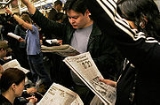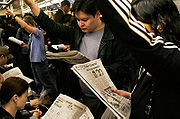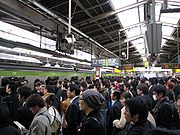
Commuting
Encyclopedia



Travel
Travel is the movement of people or objects between relatively distant geographical locations. 'Travel' can also include relatively short stays between successive movements.-Etymology:...
between one's place of residence and place of work or full time study. It sometimes refers to any regular or often repeated traveling between locations when not work related.
History
The word commuter derives from early days of rail travel in US cities such as New York, Philadelphia, Boston and Chicago, where, in the 1840s, the railways engendered suburbs from which travellers paying a reduced or 'commuted' fare into the city. Later, the back formations "commute" and "commuter" were coined therefrom. Commuted tickets would usually allow the traveller to repeat the same journey as often as they liked during the period of validity: Normally, the longer the period the cheaper the cost per day.Before the 19th century, most workers lived less than an hour's walk from their work. Today, many people travel daily to work a long way from their own towns, cities, and villages, especially in industrialised societies
Industrial Revolution
The Industrial Revolution was a period from the 18th to the 19th century where major changes in agriculture, manufacturing, mining, transportation, and technology had a profound effect on the social, economic and cultural conditions of the times...
. Depending on factors such as the high cost of housing in city centres, lack of public transit, and traffic congestion
Traffic congestion
Traffic congestion is a condition on road networks that occurs as use increases, and is characterized by slower speeds, longer trip times, and increased vehicular queueing. The most common example is the physical use of roads by vehicles. When traffic demand is great enough that the interaction...
, modes of travel may include automobile
Automobile
An automobile, autocar, motor car or car is a wheeled motor vehicle used for transporting passengers, which also carries its own engine or motor...
s, motorcycle
Motorcycle
A motorcycle is a single-track, two-wheeled motor vehicle. Motorcycles vary considerably depending on the task for which they are designed, such as long distance travel, navigating congested urban traffic, cruising, sport and racing, or off-road conditions.Motorcycles are one of the most...
s, train
Train
A train is a connected series of vehicles for rail transport that move along a track to transport cargo or passengers from one place to another place. The track usually consists of two rails, but might also be a monorail or maglev guideway.Propulsion for the train is provided by a separate...
s, bus
Bus
A bus is a road vehicle designed to carry passengers. Buses can have a capacity as high as 300 passengers. The most common type of bus is the single-decker bus, with larger loads carried by double-decker buses and articulated buses, and smaller loads carried by midibuses and minibuses; coaches are...
es, and bicycle
Bicycle
A bicycle, also known as a bike, pushbike or cycle, is a human-powered, pedal-driven, single-track vehicle, having two wheels attached to a frame, one behind the other. A person who rides a bicycle is called a cyclist, or bicyclist....
s.
Suburbs
Commuting has had a large impact on modern life. It has allowed citiesCity
A city is a relatively large and permanent settlement. Although there is no agreement on how a city is distinguished from a town within general English language meanings, many cities have a particular administrative, legal, or historical status based on local law.For example, in the U.S...
to grow to sizes that were previously not practical, and it has led to the proliferation of suburb
Suburb
The word suburb mostly refers to a residential area, either existing as part of a city or as a separate residential community within commuting distance of a city . Some suburbs have a degree of administrative autonomy, and most have lower population density than inner city neighborhoods...
s. Many large cities or conurbation
Conurbation
A conurbation is a region comprising a number of cities, large towns, and other urban areas that, through population growth and physical expansion, have merged to form one continuous urban and industrially developed area...
s are surrounded by commuter belts, also known as metropolitan area
Metropolitan area
The term metropolitan area refers to a region consisting of a densely populated urban core and its less-populated surrounding territories, sharing industry, infrastructure, and housing. A metropolitan area usually encompasses multiple jurisdictions and municipalities: neighborhoods, townships,...
s, commuter town
Commuter town
A commuter town is an urban community that is primarily residential, from which most of the workforce commutes out to earn their livelihood. Many commuter towns act as suburbs of a nearby metropolis that workers travel to daily, and many suburbs are commuter towns...
s, dormitory towns, or bedroom communities. The prototypical commuter lives in one of these areas and travels daily to work or to school in the core city. Institutions that have few dormitories
Dormitory
A dormitory, often shortened to dorm, in the United States is a residence hall consisting of sleeping quarters or entire buildings primarily providing sleeping and residential quarters for large numbers of people, often boarding school, college or university students...
or near-campus student housing are called commuter schools in the United States
United States
The United States of America is a federal constitutional republic comprising fifty states and a federal district...
.
As urban sprawl
Urban sprawl
Urban sprawl, also known as suburban sprawl, is a multifaceted concept, which includes the spreading outwards of a city and its suburbs to its outskirts to low-density and auto-dependent development on rural land, high segregation of uses Urban sprawl, also known as suburban sprawl, is a...
pushes farther and farther away from central business district
Central business district
A central business district is the commercial and often geographic heart of a city. In North America this part of a city is commonly referred to as "downtown" or "city center"...
s, new businesses can appear in outlying cities
Edge city
"Edge city" is an American term for a concentration of business, shopping, and entertainment outside a traditional urban area in what had recently been a residential suburb or semi-rural community...
, leading to the existence of the reverse commuter who lives in a core city but works in the suburbs, and to a type of secondary commuter who lives in a more distant exurb and works in the outlying city or industrial suburb.
Traffic
Most commuters travel at the same time of day, resulting in the morning and evening rush hourRush hour
A rush hour or peak hour is a part of the day during which traffic congestion on roads and crowding on public transport is at its highest. Normally, this happens twice a day—once in the morning and once in the evening, the times during when the most people commute...
s, with congestion on roads and public transport systems not designed or maintained well enough to cope with the peak demands. As an example, Interstate 405
Interstate 405
Interstate 405 may refer to:* Interstate 405 , a bypass of Los Angeles, California* Interstate 405 , a loop in Portland, Oregon* Interstate 405 , a bypass of Seattle, Washington...
located in Southern California, is one of the busiest freeways in the United States. Commuters may sit up to two hours in traffic during rush hour. Construction or accidents on the freeway distract and slow down commuters, contributing to even longer delays.
Pollution
The suburbs in the United States and elsewhere tend to have less air pollution than their neighboring inner cities, even though more workers in the inner cities use public transport. Some governments and employers have introduced employee travel reduction programs that encourage such alternatives as car-pooling and telecommutingTelecommuting
Telecommuting or telework is a work arrangement in which employees enjoy flexibility in working location and hours. In other words, the daily commute to a central place of work is replaced by telecommunication links...
. Some are also carpooling using Internet sites to save money. Alternatives like personal rapid transit
Personal rapid transit
Personal rapid transit , also called podcar, is a public transportation mode featuring small automated vehicles operating on a network of specially built guide ways...
have also been proposed to reap the energy-efficiency benefits of a mass transit system while maintaining the speed and convenience of individual transport.
Cars not carrying passengers use fuel and roads less efficiently than shared cars or public transport, and increase traffic congestion
Traffic congestion
Traffic congestion is a condition on road networks that occurs as use increases, and is characterized by slower speeds, longer trip times, and increased vehicular queueing. The most common example is the physical use of roads by vehicles. When traffic demand is great enough that the interaction...
. However, commuting alone by car is often a more efficient method for people doing so, as their travel times tend to be lower. Commuting by car is a major factor contributing to air pollution
Air pollution
Air pollution is the introduction of chemicals, particulate matter, or biological materials that cause harm or discomfort to humans or other living organisms, or cause damage to the natural environment or built environment, into the atmosphere....
. Carpool lanes help commuters reach their destinations more quickly, encourage people to drive together, and reduce air pollution.

